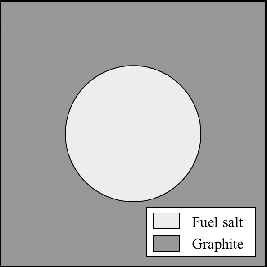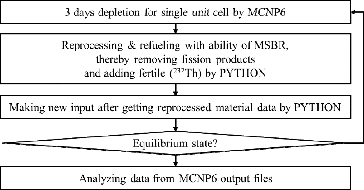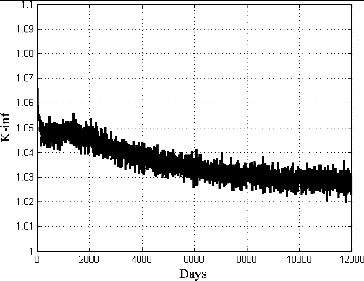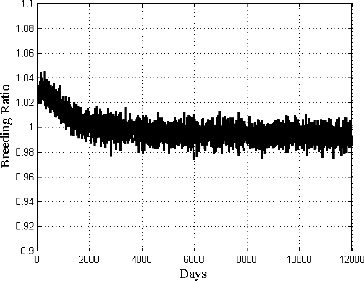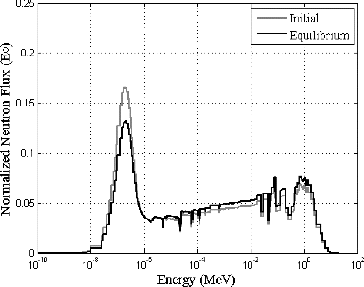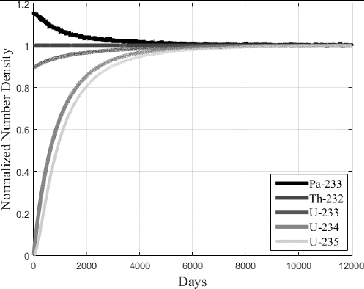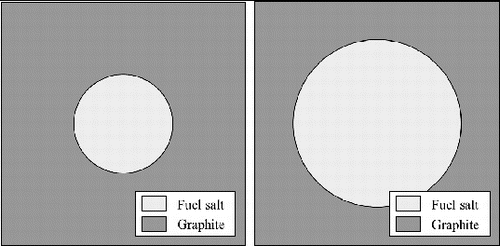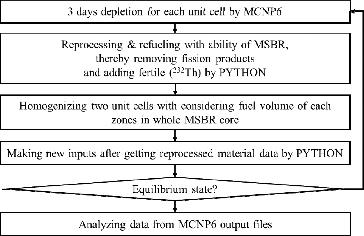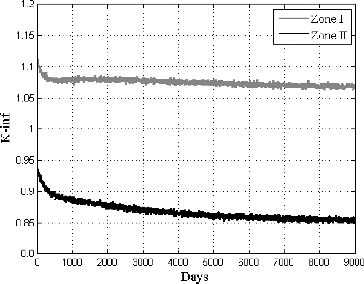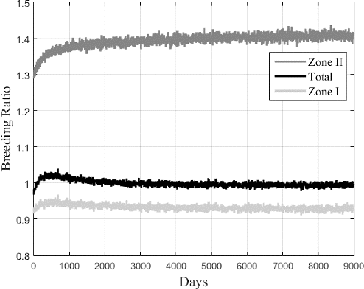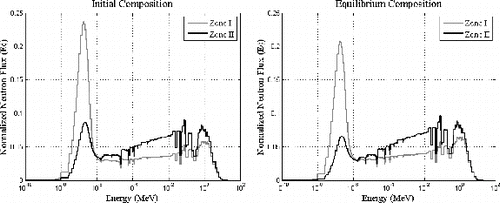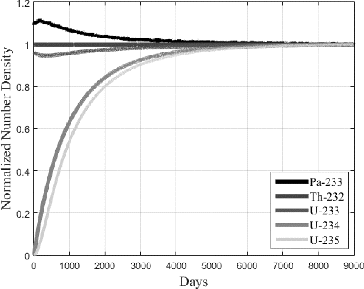Abstract
Two unit-cell-based core design methods are presented for a molten salt breeder reactor (MSBR) equilibrium core with online reprocessing and refueling: a single-cell method and a two-cell method. The single-cell method adopts a representative single unit cell which has the same fuel-to-moderator volume ratio as the average value of an MSBR core which actually consists of two zones with different ratios. The two-cell method uses two representative unit cells, one for each zone, with each zone having the appropriate fuel-to-moderator ratio. It is demonstrated that the two-cell-based method is able to catch the neutron physics of spectral interaction of the two zones with different neutron energy spectra, whereas the single-cell method cannot accurately predict the breeding ratio nor the resonance escape probability of the MSBR core. A new code system was established using MCNP6/PYTHON script language for modeling of the online reprocessing of molten fuel, and the depletion and online refueling of the MSBR core.
1. Introduction
Thermal spectrum molten salt reactors (MSRs) consist of fuel-bearing molten-salt fluid (e.g., 7LiF–BeF2–ThF4–UF4) which acts as a coolant, and the bare graphite moderator. The fluid fuel is a unique characteristic of MSRs, distinguishing them from other nuclear reactor concepts by giving special properties. The molten-salt fuel makes it possible to do online fuel reprocessing and refueling, meaning MSRs can operate long term without stopping and can achieve excellent capacity factor. This fuel does not need to be fabricated, so that the MSRs are also beneficial in terms of economics. There is also a high level of inherent safety due to the large negative temperature coefficient stemming from the large temperature expansion coefficient. In terms of the nuclear fuel cycle, the thorium cycle produces very small amounts of plutonium and minor actinides compared to the conventional uranium cycle, so it can increase the proliferation resistance, while allowing the MSR to operate as a breeder reactor. As a converter reactor, MSRs can use spent fuel, which means it uses radioactive waste from a pressurized water reactor or others. Therefore, MSRs can operate for a variety of purposes. Because of these special properties, the MSR was selected as one of the gen-IV (generation-IV) designs by the United States Department of Energy. However, the development of the MSR has almost stopped because of relatively little related technology, less operating experience and a lack of computational code for analyzing MSR cores compared to other gen-IV designs.
Oak Ridge National Laboratory (ORNL) researched and designed several MSR model. In the 1950s, there was the Aircraft Reactor Experiment (ARE) for the aircraft nuclear propulsion program [Citation1]. The reason why the MSR type reactor was selected for aircraft propulsion is the high inherent safety of MSR, especially the high thermal expansion coefficient of molten-salt fuel. The ARE operation was successful. In the 1960s, there was the molten salt reactor experiment (MSRE) project [Citation2]. The project was a feasibility study of MSR for commercial power generation. The MSRE project produced lots of experimental data regarding the MSR operation. In the 1970s, ORNL designed the molten salt breeder reactor (MSBR) based on the accumulated experimental data [Citation3]. The MSBR design is not only for the reactor core but for the whole nuclear power plant system. However, the MSBR was not built because of the changed government policy of the United States. After that, MSR research almost stopped.
Nowadays, MSR research has gained momentum because of its good characteristics, such as efficiency and safety. For the development of industry, it needs computational analysis codes and analysis methodology for characteristics of MSR. One of the most important characteristics of MSR is online reprocessing and refueling. Contemporary nuclear reactor analysis codes do not provide a depletion calculation with reprocessing and refueling. J. J. Powers in ORNL suggested a method to calculate the online reprocessing and refueling of MSBR by using the deterministic computer code NEWT in SCALE6 [Citation4]. Power set up a code system that consists of NEWT and PYTHON script language. The method proposes division of depletion time into short time intervals and batchwise reprocessing and refueling at each time step by using the code system. The method adopted a representative single unit cell for the whole MSBR core. In this paper, this method will be called the single-cell method.
The contemporary computer code MCNP6 does not support online reprocessing and refueling [Citation5]. In order to simulate MSR characteristics, it is necessary to add this function. The function can be realized by dividing the depletion time into short time intervals and batchwise reprocessing and refueling at each step, which makes it similar to real online reprocessing and refueling. Overall procedures are repeated to take material information after the depletion, during the short time interval, and make a new input by using PYTHON script language. The material processing is carried out by PYTHON in between each interval.
The MSBR core consists of two zones. Zone I is the inner part of the core and has a 13% molten salt fuel-to-graphite moderator ratio so most of the fission reaction occurs there. Zone II is the outer part of the core and has a 37% fuel-to-moderator ratio so most of the breeding occurs there. This paper is divided into two parts, the single-cell method and the two-cell method. The single-cell method adopts a representative single unit cell for both zones. The fuel-to-moderator ratio is selected as the total fuel-to-moderator ratio for both Zone I and Zone II. The single-cell method was suggested by J. J. Powers. The two-cell method adopts representative unit cells for each zone. The fuel-to-moderator ratio of each unit cell is the same as the fuel-to-moderator ratio for each zone. The two-cell method is a newly suggested method in this paper. The two methods are compared with each other in this paper and it is proved that the two-cell method is more accurate than the single-cell method. To analyze online reprocessing and refueling for both cases, the code system is set up with MCNP6 and PYTHON script language. The code system can calculate the equilibrium composition of the given problem cases. In the process of calculating equilibrium fuel composition, various parameters can be obtained to analyze the unit cell models, such as the multiplication factor, breeding ratio, change of amount of fuel, temperature coefficient and neutron flux spectrum.
In Section 2, the geometry and the reprocessing method of the single-cell method are explained, while those of the two-cell method are explained in Section 3. The multiplication factor, the breeding ratio, the neutron spectrum and the number density change are analyzed for each method. In Section 4, the difference between the singe-cell and the two-cell method is investigated based on the four factor formula. The advantages of the two-cell method compared to the single-cell method are summarized in Section 5.
2. Single-cell method
is the summary of the MSBR design parameter [Citation3]. The MSBR is a thermal spectrum reactor. The MSBR adopts molten-salt fuel and bare graphite moderator. The lithium in the molten-salt fuel is used as a fully enriched 7Li because of high thermal absorption cross section of 6Li. The uranium in the molten-salt fuel of an initial composition is used as 233U in this paper. In this paper, the Zone I region of the whole MSBR core is considered as Zone I, and the annulus region and the Zone II region of the whole MSBR core are considered as Zone II. The detailed geometry of the whole MSBR core is explained in CitationRef. [1], ORNL-4541.
Table 1. Summary of principal data for MSBR core.
The MSBR reactor core consists of two zones with one flow. It means the same composition of the molten-salt fuel is divided into two zones in the reactor core, and the graphite-to-fuel ratio is different in each zone. In this method, the two zone design is replaced by a single unit cell while maintaining the ratio between the volume of the molten-salt fuel and graphite. The pin pitch of the unit cell is 9.91 cm which is based on the pin pitch of Zone I of the whole MSBR core design. The molten-salt fuel channel radius is determined by the volume fraction of the molten-salt fuel in the unit cell (20.6%) that represents the average volume fraction of the molten-salt fuel in Zone I (13%) and Zone II (37%), so the radius of the fuel channel is 2.54 cm. shows the geometry for the unit cell calculation. Initial fuel loading composition is roughly the same as MSBR, 71.8 7LiF–16 BeF2–12 ThF4–0.2 UF4. The boundary condition of this unit cell is reflective. The density of the molten-salt is 3.28 g/cm3 and that of the graphite is 1.84 g/cm3 at 900 K. The temperature of fuel and graphite is fixed at 900 K.
2.1. Reprocessing method
The MSBR is operated by removing fission products and actinides, and adding fertile material (232Th) continuously. It also has characteristics in dealing with materials during reprocessing and refueling. For example, the MSBR has the ability to remove all volatile gases (e.g., 135Xe), noble metals in 20 seconds and so on [Citation3]. 233Pa can decay into 233U which is a fissile material but 233Pa has a large absorption cross section in the thermal spectrum, therefore the separation of 233Pa from the core and allowing 233Pa to decay to 233U outside of the core are very important. The MSBR has the ability to separate 233Pa from the molten-salt fuel over three days, and allows it to decay to 233U outside of the reactor and be recovered. The reactor prevents 233Pa from absorbing neutrons, and increases the efficiency of 233U breeding. Other fission products have specific removal rates. If the depletion time intervals are very short owing to the material being instantly removed, it is hard to obtain equilibrium composition because of too many depletion time steps. If the depletion time intervals are too long, it is hard to say the result represents online reprocessing and refueling well. For that reason, the unit time interval is set to three days that corresponds with the removal time of 233Pa which is the key isotope for breeding. 232Th is added to maintain the initial amount of 232Th. shows the depletion procedure.
2.2. Equilibrium core analysis
This method just adopts a single representative unit cell for the whole MSBR core, so it does not distinguish the characteristics of Zone I and Zone II. In the process of calculating the equilibrium composition, the code system gives parameters that represent the MSBR physics. The multiplication factor during the depletion calculation is calculated three times per a depletion interval in MCNP6. The initial multiplication factor is selected as a representative multiplication factor for the depletion interval because the fission products are produced by the computer code system during the time interval while the fission products are continuously removed in a real MSBR. represents the infinite multiplication factor calculated by MCNP6 with ENDF/B-VII.0 nuclear data. The infinite multiplication factor of MCNP6 fluctuates because of a high standard deviation (around 200 pcm).
In , the breeding ratio is calculated from the characteristics of isotopes in the thorium cycle and weight lost to capture and gain by the fission data from MCNP6 according to a short depletion time interval. The overall breeding ratio calculated from the result of the single-cell method using MCNP6 is close to 1 as it approaches the equilibrium state. As the depletion calculation approaches the equilibrium state, the breeding ratio should be one because every isotope maintains a balance including the fissile material. In , the normalized neutron flux spectrum for the equilibrium state is harder than the initial state because of heavy fission products. This spectrum will be compared to the spectrum generated by the two-cell method.
shows the normalized number density of major isotopes that have a strong impact on the state of the core, and shows the equilibrium number density of actinides in . Every isotope represents the beginning of each depletion time interval, except for 233Pa because it is removed in these intervals, so it represents the end of the depletion time intervals. adopts a normalized number density with respect to the equilibrium composition in order to easily see the change of several important actinides. When the multiplication factor and the major isotopes number density do not change with respect to time, the state is the equilibrium state. From that point of view, the composition at about 12,000 days is the equilibrium state and it can be easily perceived in the multiplication factor graph in and the normalized number density graph in
Table 2. Equilibrium number density of actinides of the single-cell method.
3. Two-cell method
As mentioned in the previous section, the MSBR reactor core consists of two zones with one flow. In this method, the two zone design is modeled by two unit cells. The size of the square-shaped graphite cells is the same as the single-cell method. The fuel channel radius is determined by the volume fraction of the molten-salt fuel in each zone; 13% for Zone I and 37% for Zone II, so the radii are 2.0 and 3.4 cm, respectively. shows the geometry for the unit cell calculation. This two-cell method differentiates the characteristics of both zones; most of the fission reaction occurs in Zone I and most of breeding occurs in Zone II. The initial fuel loading composition, boundary condition, density of materials and temperature are same as the single-cell method.
3.1. Reprocessing method
During the MSBR operation, the molten-salt fuel is continuously mixed regardless of the zone. The single-cell method does not need to consider the mixing operation but the two-cell method needs to consider it. After every three days depletion time interval, the number density is homogenized considering the total fuel volume of each zone in the whole MSBR core. In this homogenizing calculation, a velocity difference between Zone I and Zone II is not considered. In depletion calculation, computer code needs thermal power for each unit cell. The thermal power for each unit cell is decided by considering the total volume of each zone and the fission power ratio between Zone I and Zone II in the whole MSBR core. The fission power ratio between Zone I and Zone II is given in the MSBR design report [Citation3]. Except for those mixing operation and power decision, the batchwise reprocessing and refueling strategy is applied identically to the single-cell method. The overall reprocessing procedure is shown in
3.2. Equilibrium core analysis
This method adopts two representative unit cells to distinguish the characteristics of Zone I and Zone II. The depletion calculation is repeated with the given reprocessing method until the infinite multiplication factor approaches the equilibrium state. In the process of calculating the equilibrium composition, the code system gives parameters that represent the MSBR physics. The multiplication factors for both zones are plotted in . Standard deviation is about 200 pcm.
The breeding ratio is calculated in the same manner as the single-cell method. The only difference is that the two-cell method has two unit cells. In , there are three lines. The largest one is the breeding ratio for only the Zone II cell and the smallest one is the breeding ratio for only the Zone I cell. The cell for Zone I has a small fuel-to-moderator ratio so, there is a low breeding ratio. On the other hand, the cell for Zone II has a large fuel-to-moderator ratio, so the neutron energy spectrum is harder than the Zone I cell. It makes a higher breeding ratio than Zone I. The middle line is evaluated by considering the absolute value of the fissile gain and loss in each cell, and the number of each cell in the MSBR core. For the same reason mentioned in the single-cell method, the breeding ratio of the two-cell method at the equilibrium state is about 1. In , there are normalized neutron flux spectrum for the initial and equilibrium states of Zone I cell and Zone II cell. Each neutron flux spectrum of the two-cell method is quite similar with the spectrum of each zone of the whole MSBR core [Citation6]. It implies that the two-cell method can distinguish the characteristics of Zone I and Zone II of the whole MSBR core. In contrast, the singe-cell method only adopts the single neutron flux spectrum. Therefore, it is possible to think that the two-cell method can simulate the whole MSBR core better than the single-cell method, and the big difference in the neutron flux spectrum between Zone I and Zone II implies that the single-cell method has less fidelity to the whole MSBR core. The neutron spectrum for the equilibrium state is harder than the initial state because of heavy fission products.
is plotted in the same manner as . shows the equilibrium number density of actinides in . The two-cell method approaches the equilibrium state at about 9000 days. In a comparison between and , the number density of fissile isotopes for the single-cell method is slightly higher than the two-cell method. The reason why the two-cell method needs a smaller actinide number density to maintain the equilibrium state compared with the single-cell method is that the two-cell method can differentiate the two zone system of the MSBR. The MSBR consists of two zones, which have different roles, to achieve high capacity factor. The inner part of the MSBR core, Zone I, is mainly for the thermal fission reaction with a softer neutron flux spectrum and the outer part of the MSBR core, Zone II, is mainly for actinide breeding with a harder neutron flux spectrum. This means that the hard neutron flux spectrum Zone II can consume more actinides but the single-cell method cannot simulate the phenomena because there is only one neutron flux spectrum. Therefore, the two-cell method approaches a more accurate equilibrium state than the single-cell method and it can simulate the whole MSBR core better than the single-cell method.
Table 3. Equilibrium number density of actinides of the two-cell method.
4. Four factor analysis
By using the four factor formula, it is possible to see the single-cell and two-cell method more precisely [Citation7]. In , there are the four factors and the infinite multiplication factor, k∞, which is defined by the product of the four factors. The fast fission factor is represented by ϵ, p is the resonance escape probability, f is the thermal utilization factor and ηT is the thermal neutron production. The values in the table were calculated from the corresponding equilibrium composition. The thermal utilization factor and the thermal neutron production are quite similar among the single-cell method, Zone I and Zone II for two-cell method because the thermal utilization factor and the thermal neutron production are not largely affected by neutron spectrum differences originating from the fuel-to-moderator ratio. However, the fast fission factor and the resonance escape probability are definitely different. As indicated in and , the two-cell method adopts a separate neutron spectrum for each zone but the single-cell method adopts a single neutron spectrum. The two neutron spectrums in the two-cell method are very different. The neutron spectrum for the unit cell of Zone I is very soft and the neutron spectrum for the unit cell of Zone II is much harder than that of Zone I. The different fuel-to-moderator volume ratios of each cell makes the neutron spectrum different. The different volume ratios and the different neutron spectra cause the fast fission factor and the resonance escape probability to be different. Zone I has a lower fast fission factor than Zone II. Zone I has a higher resonance escape probability than Zone II. From the fast fission factor and resonance escape probability, it is possible to see the main characteristics of Zone I and Zone II. The single-cell method does not differentiate the characteristics of the two zones, so the equilibrium composition obtained from the two-cell method is more accurate than the single-cell method. In , there are four factors from the whole MSBR core analysis [Citation6]. The difference between Zone I cell of the two-cell method and Zone I of the whole MSBR core is less than 5%, but the Zone II results of the two-cell method and the whole MSBR core show some difference, especially about 30% difference in the resonance escape probability. The reason is that the two-cell method does not consider the neutron leakage. Zone I is located in the inner part of the core, so neutron leakage can be approximately ignored, but Zone II is located on the outer part of the core, so neutron leakage from Zone II to outside of the core is hard to be ignored. Therefore, there are some differences in four factors between the two-cell method and the whole MSBR core. By comparing the four factors of the single-cell, the two-cell and the whole MSBR core, however, it is possible to see the physical characteristics of the whole MSBR core is closer to the two-cell method than the single-cell method.
Table 4. Four factors of the single-cell, the two-cell and the whole MSBR core for the equilibrium core.
5. Conclusion
The single-cell and two-cell methods for the MSBR equilibrium core design are investigated by the MCNP6-PYTHON computer code system for online reprocessing and refueling. By comparing the neutron flux spectra and the four factor analysis of the single-cell method, the two-cell method and the whole MSBR core, it is easy to see that the results of the two-cell method are more representative of the MSBR core than the result of the single-cell method. The biggest difference of the single-cell and two-cell methods originates from the diversity of the fuel-to-moderator ratio in the two zones. The single-cell method only uses a single neutron flux spectrum but the two-cell method can adopt the separated neutron flux spectra for the two zones because the two-cell method can differentiate the different fuel-to-moderator ratio of each zone in the whole MSBR core. The two unit cells make it possible to simulate the whole MSBR core accurately because the neutron flux spectrum represents characteristics of each zone. The four factor formula of the single-cell and the two-cell methods shows how the different fuel-to-moderator ratio and the different neutron spectrum influence each unit-cell-based method. The comparison among the single-cell method, the two-cell method and the whole MSBR core shows that the two-cell method is more reliable than the single-cell method.
To approach the equilibrium state of the MSBR core, the two-cell method needs 1.5 times as much time as the single-cell method because the single-cell method needs 12,000 days of calculation to approach equilibrium and the two-cell method needs 9000 days of calculation with two cells. Each cell of the two-cell method can be parallelized, so the wall clock time of the depletion calculation until the equilibrium state for the two-cell method is shorter than the calculation time of the single-cell method. According to another MSBR research, if the same kind of reprocessing method is adopted to obtain the equilibrium core composition in the whole MSBR core design directly, the calculation time will be about 8 times longer than the single-cell method [Citation6]. The two-cell method can represent the MSBR core model more accurately with a less computational time than the single-cell method. Many of the thermal spectrum MSR have adopted a multi-region single-fluid strategy. The two-cell method that is proposed in this paper can be applied to other MSR cores in order to model the equilibrium core with online reprocessing and refueling.
Acknowledgements
This work was partially supported by National Research Foundation of Korea (NRF) grant funded by the Korea government (MSIP). This work was partially supported by the 2014 Future Challenge Research Fund [Project no. 1.140018.01] of UNIST (Ulsan National Institute of Science and Technology).
Disclosure statement
No potential conflict of interest was reported by the authors.
References
- Bettis ES, Schroeder RW, Cristy GA, et al. The aircraft reactor experiment design and construction. Nucl Sci Eng. 1957;2:804–825.
- Haubenreich PN, Engel JR. Experience with the molten-salt reactor experiment. Nucl Appl Tech. 1970;8:118–136.
- Robertson RC. Conceptual design study of a single-fluid molten salt breeder reactor. Oak Ridge, TN: Oak Ridge National Laboratory; 1971, ORNL-4541.
- Powers JJ, Harrison TJ, Gehin JC. A new approach for modeling and analysis of molten salt reactors using scale. In: Proceedings of M&C; 2013 May 5–9; Sun Valley (ID). [CD-ROM ].
- Pelowitz DB, editor. MCNP6 user's manual, version 1.0. Los Alamos (NM): Los Alamos National Security, LLC; 2013. LA-CP-13-00634, Rev. 0.
- Park J, Jeong Y, Lee D. Whole core analysis of molten salt breeder reactor with online fuel reprocessing. Int J Energ Res.
- Lewis EE. Fundamentals of nuclear reactor physics. Burlington: Academic Press; 2008. p. 99–107.

